Practice Free PL-400 Exam Online Questions
An organization has a Dynamics 365 Customer Engagement.
You plan to use a JavaScript web resources file in the Accounts form. The file has a dependency on two image web resource files and on the custom field new_placeofbirth in the Account entity.
You need to add the dependencies for the JavaScript file.
Which three action should you perform? Each correct answer presents part of the solution. NOTE: Each correct selection is worth one point.
- A . From Web Resources, select the JavaScript file for the Account form and then select the JavaScript file.
- B . Open the web resources file, add the two image web resources to the dependency’s lists, and then add the custom field new_placeofbirth to the dependency’s list.
- C . In the Account form, select Form Properties, select Non-Event Dependencies, and then add the custom field new_placeofbirth.
- D . In the Account form, select Form Properties and add the primary JavaScript file and the other two image web resources in Form Libraries.
- E . From Settings, select Customization and then select Customize the System.
- F . Select Account, select Forms, and then select the Account form.
CEF
Explanation:
https://docs.microsoft.com/en-us/dynamics365/customerengagement/on-premises/developer/web-resource-dependencies
You need to create an application to deploy to other pharmacies.
What should you do?
- A . Recreate customizations in a new environment.
- B . Create a customer connector to connect the pharmacies’ systems to the company’s systems.
- C . Export the solution as a managed solution.
- D . Write a Web API to move customizations.
C
Explanation:
When you export a managed solution, it contains all the changes that have been applied for that solution into a file that you can then import into a different Dataverse environment.
Reference: https://docs.microsoft.com/en-us/powerapps/developer/data-platform/introduction-solutions
DRAG DROP
You are creating a model-driven app.
Users need to see only the entities in the app navigation that are relevant to their role and their method of accessing the app.
You need to restrict entities on the sub-areas in the SiteMap.
Which properties should you use? To answer, drag the appropriate properties to the correct requirements. Each property may be used once, more than once, or not at all. You may need to drag the split bar between panes or scroll to view content. NOTE: Each correct selection is worth one point.
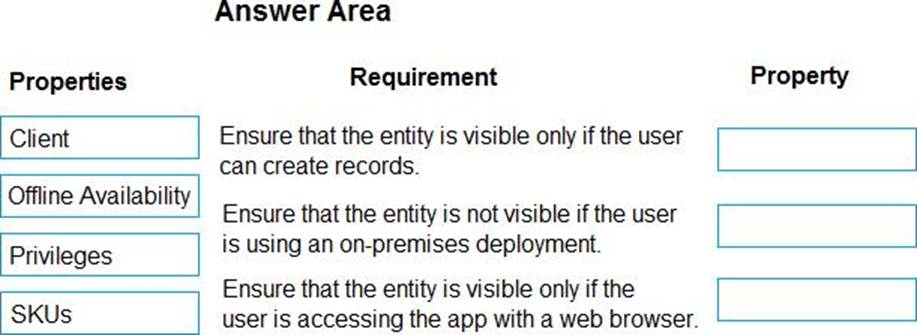
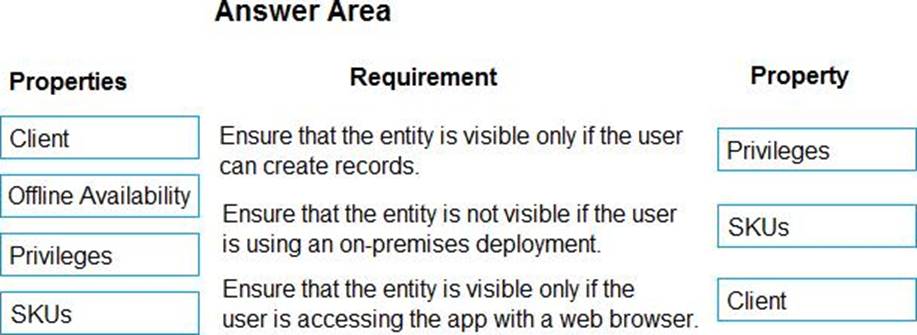
Explanation:
Box 1: Privileges
Privileges: This defines whether a subarea is displayed based on privileges available in any security
roles that are assigned to the user.
Box 2: SKU
SKUs: Select the versions of Dynamics 365 that display this subarea.
Box 3: Client
Client: Select the type of client that displays this subarea.
Incorrect Answers:
Offline Availability: Select this check box to make this subarea available to users when they are offline in Dynamics 365 for Outlook.
Reference: https://docs.microsoft.com/en-us/powerapps/maker/model-driven-apps/create-site-map-app
HOTSPOT
A model-driven app has the following JavaScript code.
The code is attached to the OnChange event of the Phone (telephone1) field on the Account entity.

For each of the following statements, select Yes if the statement is true. Otherwise, select No. NOTE: Each correct selection is worth one point.
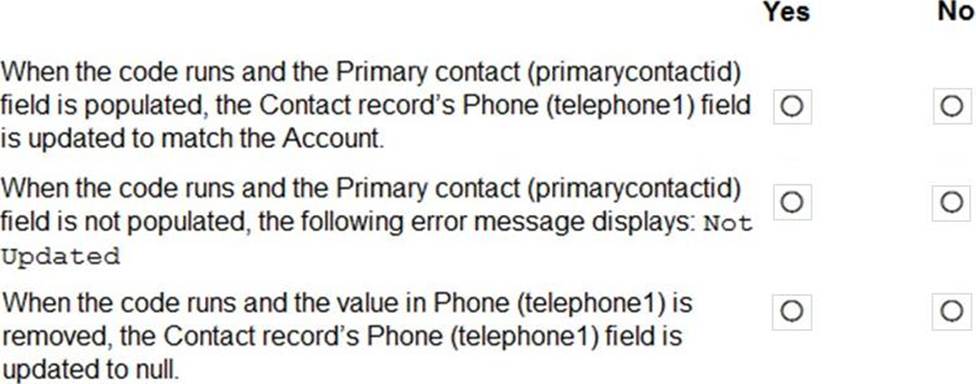
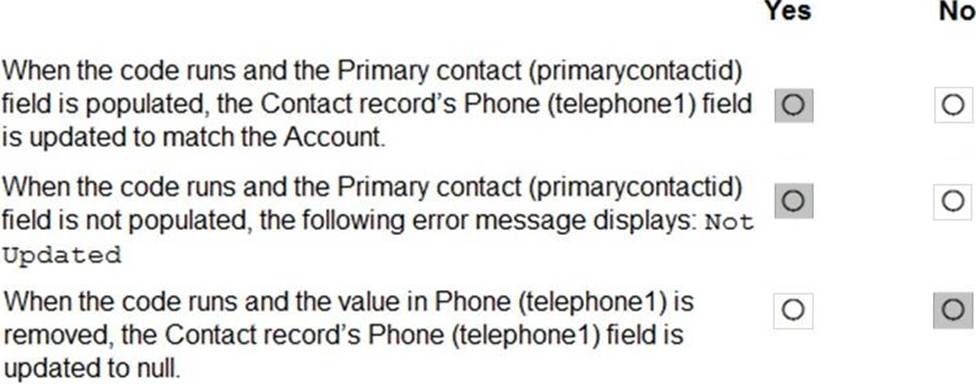
Explanation:
Box 1: Yes
Xrm.WebApi.updateRecord updates a table record.
Syntax:
Xrm.WebApi.updateRecord(entityLogicalName, id, data).then(successCallback, errorCallback);
Box 2: Yes
Box 3: No
No action would be taken.
Reference: https://docs.microsoft.com/en-us/powerapps/developer/model-driven-apps/clientapi/reference/xrm-webapi/updaterecord
A financial services company uses the Common Data Service (CDS) to develop solutions. The company uses development and production instances.
You need to move solutions from the development instance to the production instance.
What are two possible ways to achieve this goal? Each correct answer presents a complete solution. NOTE: Each correct selection is worth one point.
- A . In the development instance, make changes to the solutions that are deployed in the production instance,
export the solutions as managed solutions, and import the managed solutions into the production instance. - B . In the development instance, highlight the solution you want to make changes to, select Clone a Patch,
make changes, export the solution, and import the solution into the production instance. - C . Export all managed solutions from the development instance and import the solutions into the production instance.
- D . In the production instance, import solutions with the same version number or higher when updating solutions.
AB
Explanation:
A: When you import a managed solution, all component changes will be brought into the environment in a published state.
B: You can apply patches to either managed or unmanaged solutions and include only changes to entities and related entity assets. Patches do not contain any non-customized system components or relationships that it dependents upon because these components already exist in the deployed-to organization. At some point in your development cycle, you can roll up all the patches into a new solution version to replace the original solution that the patches were created from.
Reference:
https://docs.microsoft.com/en-us/powerapps/maker/common-data-service/import-update-export-solutions
https://docs.microsoft.com/en-us/power-platform/alm/create-patches-simplify-solution-updates
Topic 2, Adventure Works
Case study
Overview
This is a case study. Case studies are not timed separately. You can use as much exam time as you would like to complete each case. However, there may be additional case studies and sections on this exam. You must manage your time to ensure that you are able to complete all questions included on this exam in the time provided.
To answer the questions included in a case study, you will need to reference information that is provided in the case study. Case studies might contain exhibits and other resources that provide more information about the scenario that is described in the case study. Each question is independent of the other questions in this case study.
At the end of this case study, a review screen will appear. This screen allows you to review your answers and to make changes before you move to the next section of the exam. After you begin a new section, you cannot return to this section.
To start the case study
To display the first question in this case study, click the Next button. Use the buttons in the left pane to explore the content of the case study before you answer the questions. Clicking these buttons displays information such as business requirements, existing environment, and problem statements. If the case study has an All Information tab, note that the information displayed is identical to the information displayed on the subsequent tabs. When you are ready to answer a question, click the Question button to return to the question.
Background
Current environment
Adventure Works Cycles wants to replace their paper-based bicycle manufacturing business with an efficient paperless solution. The company has one manufacturing plant in Seattle that produces bicycle parts, assembles bicycles, and distributes finished bicycles to the Pacific Northwest.
Adventure Works Cycles has a retail location that performs bicycle repair and warranty repair work. The company has six maintenance vans that repair bicycles at various events and residences.
Adventure Works Cycles recently deployed Dynamics 365 Finance and Dynamics 365 Manufacturing in a Microsoft-hosted environment for financials and manufacturing. The company plans to leverage the Microsoft Power Platform to migrate all of their distribution and retail workloads to Dynamics 365 Unified Operations.
The customer uses Dynamics 365 Sales. Dynamics 365 Customer Service and Dynamics 365 Field Service.
Retail store information
✑ Adventure Works Cycle has one legal entity, four warehouses, and six field service technicians.
✑ Warehouse counting is performed manually by using a counting journal. All warehouse boxes and items are barcoded.
✑ The Adventure Works Cycles retail location performs bicycle inspections and performance tune-ups.
✑ Technicians use paper forms to document the bicycle inspection performed before a tune-up and any additional work performed on the bicycle.
✑ Adventure Works Cycles uses a Power Apps app for local bike fairs to attract new customers.
✑ A canvas app is being developed to capture customer information when customers check in at the retail location. The app has the following features:
Technology
Requirements
✑ A plug-in for Dynamics 365 Sales automatically calculated the total billed time from all activities on a particular customer account, including sales representative visits, phone calls, email correspondence, and repair time compared with hours spent.
✑ A shipping API displays shipping rates and tracking information on sales orders. The contract allows for 3,000 calls per month.
✑ Ecommerce orders are processed in batch daily by using a manual import of sales orders in Dynamics 365 Finance.
✑ Microsoft Teams is used for all collaboration.
✑ All testing and problem diagnostics are performed in a copy of the production environment.
✑ Customer satisfaction surveys are recorded with Microsoft Forms Pro. Survey replies from customers are sent to a generic mailbox.
Automation
✑ A text message must be automatically sent to a customer to confirm an appointment and to notify when a technician is on route that includes their location.
✑ Ecommerce sales orders must be integrated into Dynamics 365 Finance and then exported to Azure every night.
✑ A text alert must be sent to employees scheduled to assist in the repair area of the retail store if the number of repair check-ins exceeds eight.
✑ Submitted customer surveys must generate an email to the correct department. Approval and follow-up must occur within a week.
Reporting
✑ The warehouse manager’s dashboard must contain warehouse counting variance information.
✑ A warehouse manager needs to quickly view warehouse KPIs by using a mobile device.
✑ Power BI must be used for reporting across the organization.
User experience
✑ Warehouse counting must be performed by using a mobile app that scans barcodes on boxes.
✑ All customer repairs must be tracked in the system no matter where they occur.
✑ Qualified leads must be collected from local bike fairs.
Issues
✑ Warehouse counting must be performed by using a mobile app that scans barcodes on boxes.
✑ All customer repairs must be tracked in the system no matter where they occur.
✑ Qualified leads must be collected from local bike fairs.
Internal
✑ User1 reports receives an intermittent plug-in error when viewing the total bill customer time.
✑ User2 reports that Azure consumption for API calls has increased significantly to 100 calls per minute in the last month.
✑ User2 reports that sales orders have increased.
✑ User5 receives the error message: ‘Endpoint unavailable’ during a test of the technician dispatch ISV solution.
✑ The parts department manager who is the approver for the department is currently on sabbatical.
External
✑ CustomerB reports that the check-in app returned only one search result for their last name, which is not the correct name.
✑ Nine customers arrive in the repair area of the retail store, but no texts were sent to scheduled employees.
✑ Customers report that the response time from the information email listed on the Adventure Works Cycles website is greater than five days.
✑ CustomerC requested additional information from the parts department through the customer survey and has not received a response one week later.
You need to improve warehouse counting efficiency.
What should you create?
- A . a flow that updates the warehouse counts as the worker performs the count
- B . a model-driven app that allows the user to key in inventory counts
- C . A Power BI dashboard that shows the inventory counting variances
- D . a canvas app that scans barcodes to allow a warehouse worker to select inventory counts
D
Explanation:
Scenario: Warehouse counting is performed manually by using a counting journal. All warehouse boxes and items are barcoded.
DRAG DROP
A company has Common Data Service (CDS) environments for development, test, and production.
You have a model-driven app that consists of two solutions. The solutions include settings and reference data. You plan to move the solutions, app settings, and reference data from a development environment to a production environment.
You export each solution from the development environment as a zip file.
You run the Configuration Manager to export the settings and reference data as zip files.
You need to prepare the app and its settings for deployment.
Which four actions should you perform in sequence? To answer, move the appropriate actions from the list of actions to the answer area and arrange them in the correct order. NOTE: More than one order of answer choices is correct. You will receive credit for any of the correct orders you select.
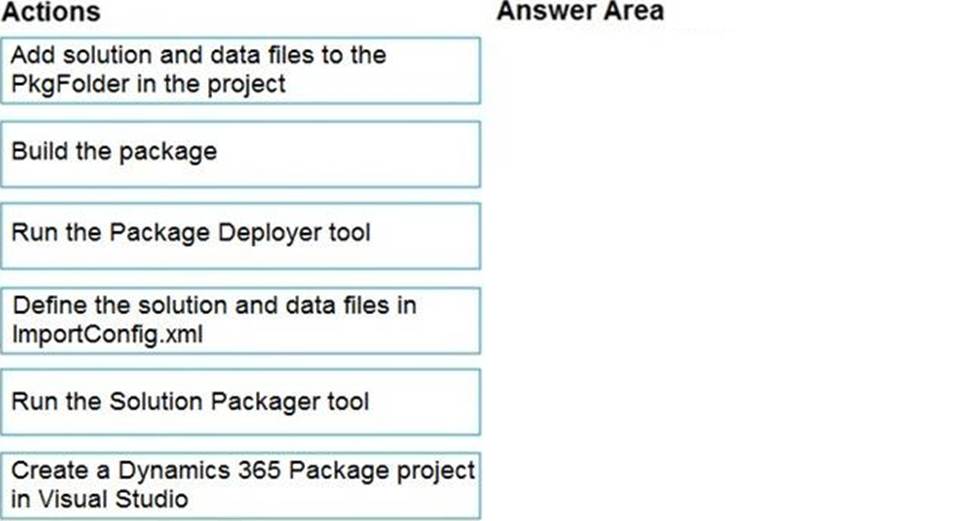
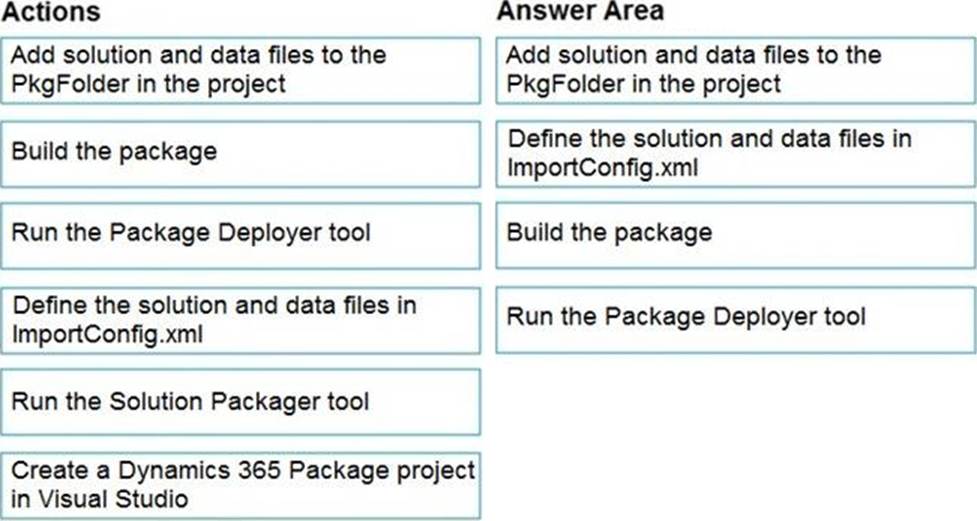
Explanation:
Step 1: Add your files to the project
In the Solutions Explorer pane, add your solutions and files under the PkgFolder folder. For each file that you add under the PkgFolder folder, in the Properties pane, set the Copy to Output Directory value to Copy Always. This ensures that your file is available in the generated package.
Step 2: Define the solution and data files in ImportConfig.xml
Define the package configuration by adding information about your package in the ImportConfig.xml file available in the PkgFolder.
Step 3: Build the package
Step: Run the Package Deployer tool
After you create a package, you can deploy it on the Dataverse instance by using either the Package Deployer tool or Windows PowerShell.
Reference: https://docs.microsoft.com/en-us/power-platform/alm/package-deployer-tool
You need to modify the Power Automate flow to resolve CustomerC’s issue.
What should you do?
- A . Add a configure run that is set to is successful.
- B . Add a data operation that specifies the false conditions.
- C . Add a condition containing approval hierarchy.
- D . Add a timeout setting to the approval flow.
D
Explanation:
Scenario: CustomerC requested additional information from the parts department through the customer survey and has not received a response one week later.
Reference: https://docs.microsoft.com/en-us/power-automate/sequential-modern-approvals
HOTSPOT
You are designing an integration between Dataverse and an external application. The external application processes thousands of records per day.
Record processing volumes vary throughout the day. Extremely high processing volumes may occur and may exceed the Dataverse service protection API limits.
You need to implement each service protection limit that is enforced.
Which implementations should you use? To answer, select the appropriate options in the answer area. NOTE: Each correct selection is worth one point.

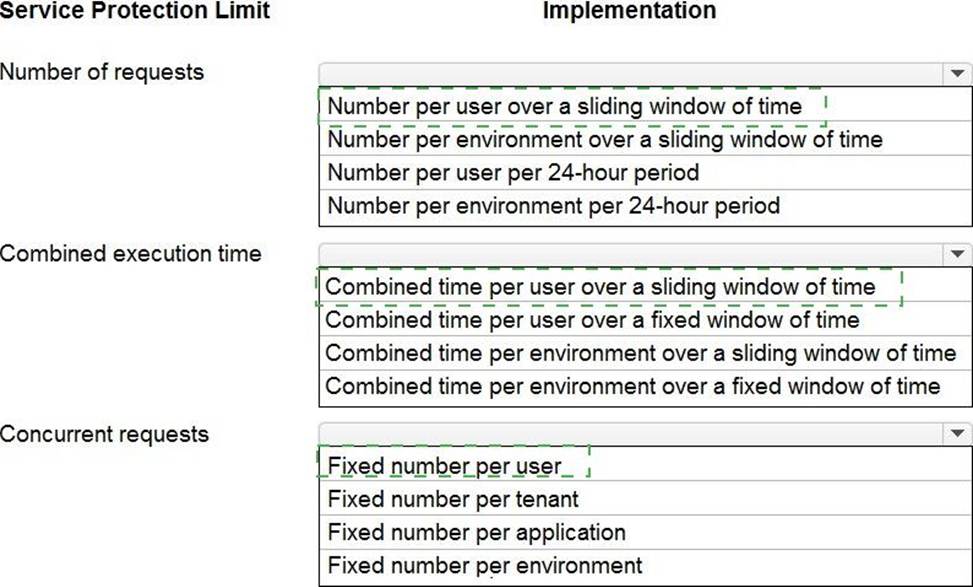
Explanation:
Box 1: Number per user over a sliding window of time
Service protection API limits are enforced based on three facets:
✑ The number of requests sent by a user.
✑ The combined execution time required to process requests sent by a user.
✑ The number of concurrent requests sent by a user.
The following table describes the default service protection API limits enforced per web server:
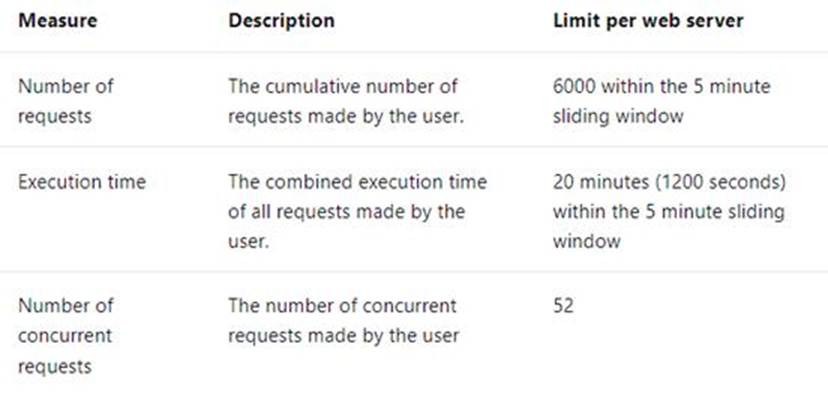
Box 2: Combined time per user over a sliding window of time
Box 3: Fixed number per user
Reference: https://docs.microsoft.com/en-us/powerapps/developer/data-platform/api-limits
You need to configure the app to meet the address verification requirements.
Which two actions should you perform? Each correct answer presents part of the solution. NOTE: Each correct selection is worth one point.
- A . Enable the command bar button only when the address shows as not verified.
- B . Make the address fields read-only after they have been verified.
- C . Open a confirmation dialog when the command bar button is selected.
- D . Clear the field indicating the address is valid when an address field changes.
